Location and Size
Okinawa is located in the southwestern islands of Japan. Okinawa is made up of 72 islands which stretch for 374 miles. The islands have names as follows: Miyako, Ishigaki, Iriomote, Kumezima, Iezima, Yonaguni, Daitou-zima, Hateruma, Iheya-zima, Izena-zima, Taketomi, The Keramas (includes Zamami, Tokasiki, Aka, Tonaki) and countless others. Okinawa is the main island in the Ryukyu Archipelago, mostly of coral origin, a chain of many islands. The name “Okinawa” means “sea rope” which looks like rope floating on the ocean. Okinawa is 485 square miles in size, 67 miles long and varies from 2 to 18 miles wide. Tokyo is located 970 miles northeast; Seoul is 750 miles northwest; and Manila is 925 miles south from Okinawa. Mainly what we need to know is that Okinawa is a series of small islands a long, long way by sea from the nearest mainland or large island
Climate
Average temperature for July, usually the warmest month of the year, is 85 F (30 degrees Celsius). Average temperature for February, usually the coolest month of the year, is 60 F (15 degrees Celsius). Therefore, summer in Okinawa could be very hot and wet. If you are not accustomed to the heat, you may find Okinawa uncomfortable. Typhoons occur between the months of June and November.
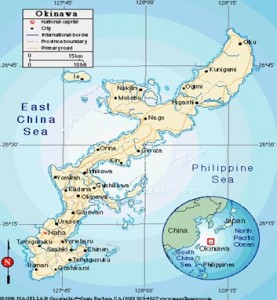
Tonfa
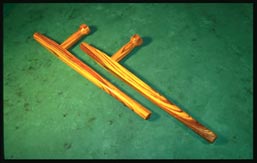 Like the other kobudo weapons, tonfa was used as a working tool, before being a weapon. The tonfa was an arm of a millstone for preparing grain, which could easily be removed.
Like the other kobudo weapons, tonfa was used as a working tool, before being a weapon. The tonfa was an arm of a millstone for preparing grain, which could easily be removed.
The main part of the tonfa, the shaft, consists of a large hardwood body, about 50 to 60 centimetres in length, and a smaller cylindrical grip secured at a 90 degrees angle to the shaft, about 15 centimetres from one end.
Some photos about using Tonfa
Sai
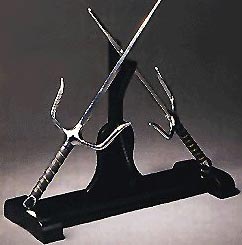 Again, the sai was a simple farm instrument which the peasants turned to their advantage once they were forbidden to carry weapons. Usually, the sais are used in pairs. A third sai was hidden in the obi (belt) and was used to replace one sai that was thrown at the charging enemy. If the throw was successful, the fight could be over all at once. If not, the distraction could be just enough to get close to stab with the sai or to counter an attack and win the battle.
Again, the sai was a simple farm instrument which the peasants turned to their advantage once they were forbidden to carry weapons. Usually, the sais are used in pairs. A third sai was hidden in the obi (belt) and was used to replace one sai that was thrown at the charging enemy. If the throw was successful, the fight could be over all at once. If not, the distraction could be just enough to get close to stab with the sai or to counter an attack and win the battle.
The stem of the sai should cover the complete forearm, to guarantee full protection when countering an attack. The butt of the handle can have various shapes ans can be used in the same way as a bullet.
Another version of the sai, called jutte or jitte was a weapons used by the Japanese police. It is smaller than the sai and has only one prong
Kama
The kama is an agricultural sickle and many were certainly imported from China for the farming classes. It has a long wooden handle and a thin razor-sharp curved blade at one end. It makes a formidable weapon even against the most determined enemy. Used in pairs they were flexibly reversed in the hand for both slashing and striking in a great many directions.
If, however, the modern sickle resembles the ones used by the feudal farming class, it is apparent that one single blocking technique would sever the blade from the shaft and make it useless. (The Shureido kama, above, has blades 3/16″ thick and sturdy red oak shafts to withstand the rigors of kobudo. The shafts have been wrapped where they come in contact with other weapons. It is, however, very heavy to use and requires consistent training to strengthen one’s hands and avoid flying, sharpened kama!) Once again it is probable that more sturdy kama were constructed for fighting – although farming ones were no doubt also used.
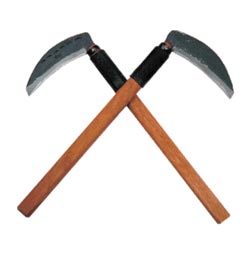 The techniques of this weapon are not often seen in modern times and there are only two registered kata in Japan today, called Kanigawa and Tozan. Kata with this weapon, like the sai or tonfa, usually assumes that you will have one in each hand. And any time you work with two weapons you run a greater risk of accident than when you need control only one. Your mind must be in two places at once, divided between two objects. Then there is the fact that the kama is sharp-edged, able to cut a serious gash in the human body when swung with maximum force and speed.
The techniques of this weapon are not often seen in modern times and there are only two registered kata in Japan today, called Kanigawa and Tozan. Kata with this weapon, like the sai or tonfa, usually assumes that you will have one in each hand. And any time you work with two weapons you run a greater risk of accident than when you need control only one. Your mind must be in two places at once, divided between two objects. Then there is the fact that the kama is sharp-edged, able to cut a serious gash in the human body when swung with maximum force and speed.
In addition, most skilled practitioners consider it a point of honor to use live blades in big martial arts demos, when their skill is being displayed. Some like Ota even train with the razor-sharp blades exposed. Losing control for a split second can mean injury, even death. And third, though this is an advanced stage of training, in many techniques only one kama is kept in the hand- the other is swung by a rope, wrapped about the body, twirled around behind the head, the neck, the waist. The combat origin of this last aspect of training is fairly simple. No matter how skilled, the karateka can only look in one direction at a time. The kama whirling behind him helps to cover his rear against attack. He can dispatch the enemy in front with one weapon, while the dangerous and unpredictable wrapping, whirling movements of the other help keep a second assailant at bay.
Nunchaku
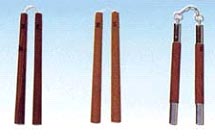 As all other okinawan weaponry, the origin of this weapon is obscure. Some say it has a Chinese origin, others say it was developped from a horsebit, but it seems like it was used by peasant to beat the rice. It probably came into action somewhere in the 16th century, like saï, tonfa, etc. The nunchaku is made out of 2 sticks, usually some hard wood, and connected with a rope (it used to be a horsetailhair) or a chain. As the sticky vary in length, size and weight, so does the length of the connection between the two sticks. The nunchaku stick is normally as long as the forearm but it is up to your personnal favor to make it as long as you want.
As all other okinawan weaponry, the origin of this weapon is obscure. Some say it has a Chinese origin, others say it was developped from a horsebit, but it seems like it was used by peasant to beat the rice. It probably came into action somewhere in the 16th century, like saï, tonfa, etc. The nunchaku is made out of 2 sticks, usually some hard wood, and connected with a rope (it used to be a horsetailhair) or a chain. As the sticky vary in length, size and weight, so does the length of the connection between the two sticks. The nunchaku stick is normally as long as the forearm but it is up to your personnal favor to make it as long as you want.
The nunchaku stick is divided into 3 parts: the upper part (jokon-bu), the middle part (chukon-bu) and the lower-part (kikon-bu). The top of the stick is called kontoh and the rope passes through the hole (ana). The bottom of the nunchaku is called kontei.
 There are a heap of variations of a normal nunchaku. It seems that the Chinese had a round stick nunchaku, or maru gata nunchaku. The Japanese made it a little more efficient by making the sticks octogonal (8 sides). This nunchaku is called hakabukei nunchaku. Then, there is a nunchaku with one long stick and a short stick, which is called so setsu kon nunchaku. It should prevent you from hitting your own hand when you miss a hit. The han kei nunchaku is made out of 2 halfs of a stick which fit nicely together and makes it easy to carry. The san setsu kon nunchaku is the 3 sectional staff. The sticks may vary in size. Sometimes, the middle one is a little shorter than the outer ones. Another variation of this nunchaku has one normal stick, and the other side is composed out of 2 shorter sticks. It makes it harder to block an attack and it is easier to loop another weapon or attacker with this nunchaku. Another variation, the yon setsu kon nunchaku is made out of 4 sticks: long piece/short piece/rope/short piece/ long piece
There are a heap of variations of a normal nunchaku. It seems that the Chinese had a round stick nunchaku, or maru gata nunchaku. The Japanese made it a little more efficient by making the sticks octogonal (8 sides). This nunchaku is called hakabukei nunchaku. Then, there is a nunchaku with one long stick and a short stick, which is called so setsu kon nunchaku. It should prevent you from hitting your own hand when you miss a hit. The han kei nunchaku is made out of 2 halfs of a stick which fit nicely together and makes it easy to carry. The san setsu kon nunchaku is the 3 sectional staff. The sticks may vary in size. Sometimes, the middle one is a little shorter than the outer ones. Another variation of this nunchaku has one normal stick, and the other side is composed out of 2 shorter sticks. It makes it harder to block an attack and it is easier to loop another weapon or attacker with this nunchaku. Another variation, the yon setsu kon nunchaku is made out of 4 sticks: long piece/short piece/rope/short piece/ long piece
Bo
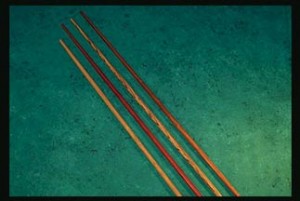 The bo, or stick is probably one of the first weapons that mankind used to defend or hunt. It could easily be found, was not to difficult to handle, and could be used for multiple purposes. In Okinawa, the bo probably originated from a farmtool called tenbin. It is a stick held across the shoulders, on which fish or waterbuckets could be hung. It could also be originated from walking sticks monks used to ease hiking and eventually defend themselves. The techniques executed with the bo, were probably developed very early in history, and were probably refined after the
The bo, or stick is probably one of the first weapons that mankind used to defend or hunt. It could easily be found, was not to difficult to handle, and could be used for multiple purposes. In Okinawa, the bo probably originated from a farmtool called tenbin. It is a stick held across the shoulders, on which fish or waterbuckets could be hung. It could also be originated from walking sticks monks used to ease hiking and eventually defend themselves. The techniques executed with the bo, were probably developed very early in history, and were probably refined after the
